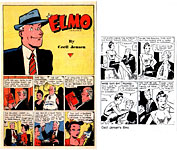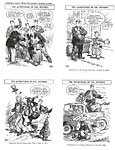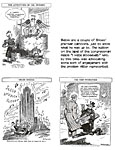Cecil
Jensen, Elmo, and Colonel M’Cosmic
The First
Editoonist to Simultaneously Draw a Comic Strip
CECIL JENSEN,
unbeknownst to him, was one of my early cartooning idols. Because of Elmo. But Jensen, as I subsequently found out, did more than that fondly recollected
comic strip.
Jensen,
Dan Nadel tells us in his Art Out of Time: Unknown Comics Visionaries,
1900-1969, was born in 1902 in Ogden, Utah, but he spent most of his
professional life in Chicago, whence he had wended his way after graduating
high school to study at the Chicago Academy of Fine Arts. After two years of
that, he worked for a variety of newspapers, including, in the early 1920s, the Los Angeles Illustrated Daily News. One day, Jensen told John Chase in Today’s Cartoon (a 1952 biographical survey of the editorial cartooning
profession), the regular cartoonist came in too drunk to draw. “I got the job,”
said Jensen.
Four
years later, he was back in Chicago at the Chicago Daily News, where he
worked for the rest of his career.
He
was the second string editoonist at the News; the first stringer was the
famed Vaughn Shoemaker. Jensen drew an editorial cartoon six days a week
(thereabouts): his cartoon appeared on the same page as Shoemaker’s. Shoes did
a three-column cartoon at the top of the page; Jensen filled two columns at the
bottom. Except on Saturday, which was Shoes’ day off, and then Cees did a
3-column ’toon for the top of the page. So—two editoons per issue: one by
Shoes, one by Cees.
Jensen
occupies a fond niche in my memory for his creation of the world’s stupidest
comic strip hero in the eponymous Elmo. Nadel supplies the tidbit that Jensen
created the strip in response to a challenge from his executive editor, Basil
(Stuffy) Walters, to whom Jensen had confided that “the comics in the News smell.” To which Walters responded: “All right—you draw a strip.” And so Jensen
did.
The
late Ed McGeean, a cartoonist friend of mine who worked at the News for
years, once told me that Shoes had no faith in Cees’ creation: he told Jensen
that Elmo wouldn’t succeed because the protagonist was too stupid. Maybe
Shoes never heard of Li’l Abner. Then again, Elmo was stupider than Abner. When
asked how Elmo would be different than other comic strips, Jensen retorted:
“The strip is supposed to be funny.” And I thought it was, hilariously so.
Elmo started October 28, 1946, and then in
1949, Elmo was supplanted as the star and lost title billing to a moppet named
Little Debbie. The strip continued under that title until 1961. Elmo was a
sort of urban Li’l Abner—except that Elmo was dumber than Abner. I admired this
kind of stupidity in a comic character. And Elmo made it all seem so easy, too—smiling
his bland, ear-to-ear grin the whole time. I loved it. I copied Elmo’s jaw and
grin in the lead characters of the comic strips I concocted in my bygone youth.
Elmo
spent most of his career working in the office of a breakfast cereal
manufacturer. Elmo actually owned the company. The previous owner, oppressed
by the responsibilities of being a millionaire and owner of a major company,
was about to jump off a bridge to his death when he was interrupted by Elmo.
Elmo, as we can see in our first visual aid (selected from the second week of
the strip’s run), suggests that the millionaire’s problems would evaporate once
he’d been swindled out of his fortune. The plutocrat, impressed by Elmo’s
irrefutable logic, gives all his fortune (stock in the cereal company) to Elmo,
saying that now Elmo will have to commit suicide.
That,
like most of what Elmo attempts, doesn’t quite work out as Elmo intends.
Eventually,
Elmo returns to his job at the cereal company, now as its owner. He is, of
course, too stupid to know that the owner of the company should be giving the
orders. Instead, he takes orders from the Commodore, an unscrupulous robber
baron who is running the company at the time. The Commodore, seeking to get
Elmo occupied with something to keep him out of his, the Commodore’s, hair,
hires a movie star to work as Elmo’s secretary. This is Sultry. And she is.
Meanwhile, perky Emmaline, Elmo’s girlfriend from back home, gets wind of all
this and comes to the big city to keep an eye on things. About this time, cute
Little Debbie shows up and becomes the face on the cereal box, selling billions
of bushels of cereal. The portion of Elmo that’s reprinted in Art
Out of Time comes from the one-shot Elmo comic book of 1948, which
completes the introductory sequence of the strip, and Little Debbie shows up at
the end of the book. 
You
can’t keep a good sales girl down. Little Debbie took over, as I said,
elbowing Elmo off the marquee of his own strip. But by then, Elmo had
dropped out of the Denver Post, my hometown paper, and so I lost track
of the whole thing.
Jensen
may have been the first editorial cartoonist to produce at the same time a
syndicated comic strip although for much of Elmo/Little Debbie’s run he
produced only one editorial cartoon a week. But he was noted in Chicago circles
for another creation. Colonel M’Cosmic. Colonel M’Cosmic was vaguely
reminiscent of David Low’s fatuous Colonel Blimp (see Opus 202). But
Colonel M’Cosmic was celebrated in Chicago for his resemblance to another
fatuous pseudo military man, Colonel Robert (“Bertie”) McCormick, publisher of
the Chicago Tribune, the powerful rival of the Daily News.
McCormick
had received his commission as a colonel when he joined the Illinois National
Guard on the eve of World War I. It was a rank he earned solely by reason of
his political position as publisher of the Tribune, but McCormick so
loved the title that he retained it ever after. He had virtually no combat
experience during the European adventure and no military training to speak of;
but he fearlessly offered his opinion on military matters on the editorial page
of the Tribune whenever the subject came up on the paper’s news columns.
And he regularly harangued a radio audience from the pulpit of station WGN, the
station owned by the World’s Greatest Newspaper (as the Colonel modestly
denominated his newspaper).
The
Colonel offered his opinion fearlessly on all manner of subjects. So varied
were these subjects that the Colonel could well be imagined the world’s
foremost authority on every subject. But military matters—and war—were his
specialty. That and geopolitics generally. All during the 1930s, McCormick
lectured the world on the dangers of Nazism. In these editorial lectures, he
displayed, as his enemies were fond of saying, “one of the finest minds of the
fourteenth century.”
When
war broke out in Europe upon the German invasion of Poland in September 1939,
McCormick quickly proclaimed that “this is not our war.” The British and the
French were thoroughly competent to fight it without American assistance. In
his editorial cartoons, Shoes and Cees ridiculed McCormick and other
non-interventionists for the nativity of their views. But McCormick remained
resolutely isolationist. Until Pearl Harbor. Then the Trib was
resolutely bellicose: “We have only one task,” the paper blared, “and that is
to strike with all our might.”
Despite
this stance, McCormick continued to be critical of the government’s conduct of
the war effort and other related matters. His criticism was viewed in some
quarters as treasonous. One Chicago citizen, Jacob Sawyer, even wrote the
Colonel a letter, expressing the fear that the Tribune’s editorial
pronouncements were undermining the morale of the country. To this, McCormick
responded with a letter that eventually found its way into print in the Daily News.
McCormick
began by pointing out that Sawyer was making a mistake in believing the
powerful propaganda circulated by McCormick’s enemies. What they saw as a
campaign of hatred was actually, the Colonel said, “a constructive campaign
without which the country would be lost.” And then he went on to cite his
credentials as savior of his country by regaling Sawyer with a list of his
accomplishments in the military. “You do not know it,” McCormick rumbled, “but
the fact is that I introduced the ROTC into the schools; I introduced machine
guns into the army; I introduced mechanization; I introduced automatic rifles.
...” And so on in this vein. A remarkable display of ego, bombast, and
pomposity bordering on megalomania. And when the Daily News got its
hands on this epistle, it published it with unmitigated glee.
And
on March 25, 1942—the U.S. now plunging into hostilities in Europe and in the
Pacific—Jensen produced a cartoon to celebrate the occasion, showing Colonel
M’Cosmic surrounded by other Colonel M’Cosmics, all claiming firsts in one
military milestone after another. M’Cosmic appeared periodically in the pages
of the News thereafter, each time commemorating another of McCormick’s
pontifical pronouncements. Several of Jensen’s achievements appear hereabouts.
(A couple of these appeared in Opus 205, wherein these paragraphs first
appeared several years ago in a slightly less garnished form; I’ve since found
others of the famed M’Cosmic series, which I’ve included herewith. And I’m
repeating the text from Opus 205 because I don’t want Jensen’s historic
achievement to be lost in the welter of Rancid Raves, the ongoing and
untrammeled chronicle perforce; better here, in the “history” department.)
 |
 |
Genius
is in the details. Notice the hilarious accouterments: M’Cosmic wears a WWI
helmet and spurs (the mark of his stature as a cavalryman, the only kind of
officer to be, forsooth) and around his neck, a pair of binoculars (another
mark of elite officer status). Always, M’Cosmic is accompanied by a round-headed
kid, a juvenile doorman (judging from his uniform)—the M’Cosmic Grenadier, no
doubt.
So
that’s the story of Jensen’s other triumph. When John S. Knight bought the Daily
News in 1944, he told Cees to cease and desist: Knight wanted to make friends
in Chicago, not enemies. And so Colonel M’Cosmic faded away, like the old
soldier he was, to be exhumed occasionally, as he is here—fondly, wistfully.
Thankfully.
Return to Harv's Hindsights |